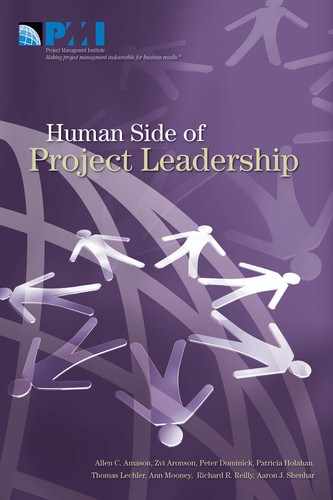CHAPTER 9
Expression Components of Spirit
Collective Attitudes
We define attitudes as an internal state that influences an individual’s choices or decisions to act in a certain way under particular circumstances (Cannon-Bower et al. 1995). We focus on attitudes that have been shown to have a direct bearing on the team’s interaction process and the ability of a person to flourish in a team. Of major importance in the dynamic and temporary context of project teams is the level of satisfaction, commitment, and morale achieved by those teams.
Project team satisfaction is the extent to which project team members are satisfied with their project team members, with the way the project team members work together, and with working in the project team. Commitment is the extent that project team members identify and are involved with the project team. And morale is defined as the willingness to engage in extreme effort (Borman and Motowidlo 1993).
Collective Emotions
In what they define as the passion zone, Bruch and Ghoshal (2003) describe company employees that thrive on strong, positive emotions such as joy and pride in their work. Employees’ excitement means that attention is directed toward shared priorities.
We define emotions as overt reactions that express feelings about events (Weiss and Cropanzano 1996). We looked at the following categories of emotions: joy, surprise, excitement, passion, and enthusiasm. Despite their differences, emotions always have an object, as Bruch and Ghoshal imply—something or someone triggers emotions. For example, each project is a first of its kind, a pioneering endeavor, which may turn new ideas into reality, thus triggering excitement!
Behavioral Norms
In project settings, behavioral norms emerge as an inevitable creation of the project leader. The leader’s decisions and actions, the topography, and the physical and social environment nurtured by the leader in which participants find themselves strongly shape the human interactions. From these interactions, an implicitly or explicitly agreed-upon set of objectives, state of affairs, behaviors, and outcomes emerge that are deemed more important, worthy, and preferred than others, referred to as behavioral expectations or norms.
When we observe behavioral norms that value collaboration, teamwork, involvement of the customer, and constructive conflict management, we refer to a culture of inclusion. A value placed on quality and efficiency should be apparent in the behaviors of project members as well. Such values reflect a healthy balance of people and task-related concerns, make people aware of what is important, and direct behavior to contribute to the project’s competitive advantage and fulfill the project’s vision.
Spirit-building activities, implemented by great leaders, foster behavioral norms that alter several behavioral outcomes which are paramount for successful project implementation. Specifically, we center on the role spirit plays in generating collaboration, citizenship behavior, and retention.
Collaboration commonly refers to the coming together of diverse interests and people to achieve a common purpose by means of interactions, information sharing, and coordination of activities (Jassawalla and Sashittal 1998). Overcoming the problems created by physical and perceptual distances among functional groups, ensuring early involvement of all participants, and joint sharing of responsibility in ways that ultimately improve and accelerate project implementation are among the commonly described advantages associated with collaboration.
Citizenship behavior goes one step further, and focuses on individuals who are willing to go above and beyond their prescribed roles to voluntarily help coworkers achieve project objectives, and refrain from complaining or finding fault with other project participants (Koys 2001). Helping coworkers frees up the project managers to implement more important tasks and, by not complaining when conditions are challenging, individuals can invest their time implementing the project productively.
We highlight retention as an outcome as well, since reducing turnover among competent professionals working in project settings at technological driven organizations is increasingly critical to sustain competitiveness (Boudreau and Ramstad 2003).
